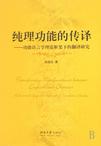纯理功能的传译-功能语言学理论框架下的翻译研究
2007年9月1日
第1版 (2007年9月1日)
赵德全
202
无
《纯理功能的传译:功能语言学理论框架下的翻译研究》从系统功能语言学的角度对英汉翻译进行了研究,主要探讨了纯理功能的传译,并从功能语言学和纯理功能的角度剖析了翻译界一直争论不休的话题——“直译”和“意译”,认为“直译”和“意译”的灵活使用是纯理功能的动态传译的最佳手段。该研究的理论基础是系统功能语言学、中国翻译史上的“忠实”概念和国外翻译界的“对等”概念。
ForewordChapter 1 Introduction1.1 Introduction1.2 Theoretical bases1.2.1 Systemic analysis on attempted texts1.2.2 Traditional Chinese translation theory1.2.3 Contemporary western theories1.3 The statement of the problems1.4 The goals of the study1.5 The scope of the study1.6 Procedures1.7 The outline of the studyChapter 2 Faithfulness and Equivalence2.1 Introduction2.2 Faithfulness2.2.1 The early concept of faithfulness in translation2.2.2 Xuan Zang's faithfulness2.2.3 Translation practice following the Tang dynasty2.2.4 Yan Fu's faithfulness2.2.5 Translation theory in present China2.3 Equivalence2.3.1 Nida's concept of equivalence2.3.2 Catford and translation equivalence2.4 Systemic view On translation and equivalence2.5 SummaryChapter 3 Transferring Ideational Function3.1 Introduction3.2 Systemic functional perspective on languages3.3 Metafunctions3.4 Ideational functions and transitivity system3.5 Preservation of ideational components3.6 Ideational components in poetry3.7 Shifts in translation3.7.1 Order shifts3.7.2 Rank shift3.7.3 Structure shift3.8 SummaryChapter 4 Transferring Interpersonal Function4.1 Introduction4.2 Interpersonal function of language4.2.1 Speech functions4.2.2 Constituents of the mood4.2.3 Constituents of the residue4.2.4 Modality4.3 Transferring interpersonal function4.3.1 The interpersonal meaning in the ideational content4.3.2 Prioritized interpersonal function4.3.3 Transferring interpersonal function in opera translation4.3.4 Transferring interpersonal function in novel translation4.4 The balance between ideational function and interpersonal function4.5 SummaryChapter 5 Transferring Textual Function5.1 Introduction5.2 Textual function of languages5.2.1 Theme and rheme5.2.2 Given and new5.2.3 Cohesion and coherence5.3 Transferring textual function5.3.1 Theme-rheme system in translation5.3.2 Information system in translation5.3.3 Focus-shifts in translation5.3.4 Cohesion and coherence in translation5.4 SummaryChapter 6 Literal Translation and Free Translation6.1 Introduction6.2 Traditional concepts of literal and free translation6.2.1 Early concepts of literal and free translation in China6.2.2 Xuan Zang's strategy in Buddhist translation6.2.3 Yan Fu-a practitioner of free translation6.2.4 Lu Xu's adherence to the literal translation6.2.5 Concepts of literal translation and free translation in western countries6.2.6 Xu Yuanchong's summary on literal and free translation6.3 Functional perspective on literal and free translation6.3.1 Nature of literal and free translation6.3.2 Automatization and de-automatization6.3.3 Transferring ideational function: from literal translation to free translation6.4 SummaryChapter 7 Conclusion7.1 Introduction7.2 Questions involved7.3 Major findings7.4 Implications and applications7.5 Limitations and suggestionsBibbiography

无
纯理功能的传译-功能语言学理论框架下的翻译研究 PDF格式下载